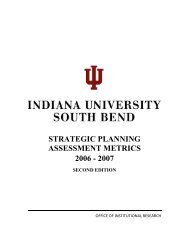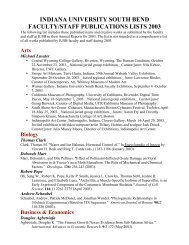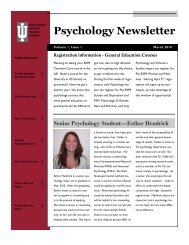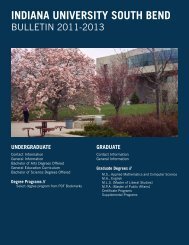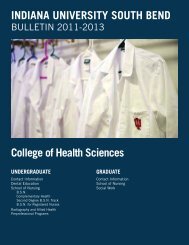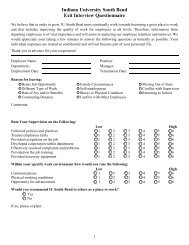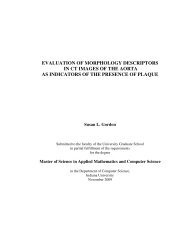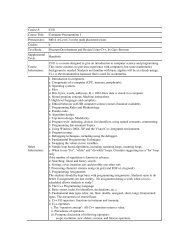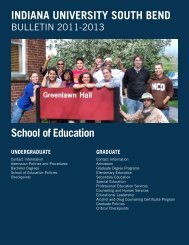Current version - Indiana University South Bend
Current version - Indiana University South Bend
Current version - Indiana University South Bend
Create successful ePaper yourself
Turn your PDF publications into a flip-book with our unique Google optimized e-Paper software.
IU SOUTH BEND COURSE DESCRIPTIONS 4357<br />
MATH-M 551<br />
MATH-M 560<br />
MATH-M 562<br />
MATH-M 565<br />
MATH-M 571<br />
performance of interconnected systems,<br />
including use of block diagrams, Bode<br />
plots, Nyquist criterion, and Lyapunov<br />
functions; optimal control, bang-bang<br />
control; discrete and digital control.<br />
MARKETS AND ASSET PRICING (3 cr.)<br />
P: Two courses from the following:<br />
MATH-M 301, MATH-M 311, MATH-M<br />
343, MATH-M 365, MATH-M 447.<br />
Interest theory; introduction to theory<br />
of options pricing; Black-Scholes theory<br />
of options; general topics in finance as<br />
the time value of money, rate of return<br />
of an investment, cash-flow sequence,<br />
utility functions and expected utility<br />
maximization, mean variance analysis,<br />
optimal portfolio selection, and the<br />
capital assets pricing model; topics in<br />
measurement of interest.<br />
APPLIED STOCHASTIC PROCESSES (3 cr.)<br />
P: MATH-M 301, MATH-M 463 or<br />
MATH-M 365, or consent of instructor.<br />
Simple random walk as approximation<br />
of Brownian motion. Discrete-time<br />
Markov chains. Continuous-time Markov<br />
chains; Poisson, compound Poisson, and<br />
birth-and-death chains; Kolmogorov’s<br />
backward and forward equations; steady<br />
state. Diffusions as limits of birth-anddeath<br />
processes. Examples drawn from<br />
diverse fields of application.<br />
STATISTICAL DESIGN OF EXPERIMENTS (3 cr.)<br />
P: MATH-M 365, MATH-M 466, or<br />
consent of instructor. Latin square,<br />
incomplete blocks, and nested designs.<br />
Design and analysis of factorial<br />
experiments with crossing and nesting<br />
of factors, under fixed, random, and<br />
mixed effects models, in the balanced<br />
case. Blocking and fractionation of<br />
experiments with many factors at two<br />
levels. Exploration of response surfaces.<br />
analysis of variance (3 cr.)<br />
P: MATH-M 466 and some matrix<br />
algebra. General linear hypothesis.<br />
Least squares estimation. Confidence<br />
regions. Multiple comparisons. Analysis<br />
of complete layouts. Effects of departures<br />
from underlying assumptions. Analysis of<br />
covariance.<br />
ANAlysis of numerical methods I (3 cr.)<br />
P: CSCI-C 101, MATH-M 301, MATH-M<br />
311, or consent of instructor. R: MATH-M<br />
343. Solution of systems of linear equations,<br />
elimination and iterative methods, error<br />
analyses, eigenvalue problems; numerical<br />
methods for integral equations and<br />
MATH-M 572<br />
MATH-M 574<br />
MATH-M 575<br />
MATH-M 576<br />
MATH-M 577<br />
ordinary differential equations; finite<br />
difference, finite element, and Galerkin<br />
methods for partial differential equations;<br />
stability of methods.<br />
ANAlysis of numerical methods ii (3 cr.)<br />
P: MATH-M 343, MATH-M 571. Solution of<br />
systems of linear equations, elimination and<br />
iterative methods, error analyses, eigenvalue<br />
problems; numerical methods for integral<br />
equations and ordinary differential<br />
equations; finite difference, finite element,<br />
and Galerkin methods for partial differential<br />
equations; stability of methods.<br />
applied regression analysis (3 cr.)<br />
P: MATH-M 466 or MATH-M 365 or<br />
MATH-M 261. Least square estimates<br />
of parameters; single linear regression;<br />
multiple linear regression; hypothesis<br />
testing and confidence intervals in linear<br />
regression models; testing of models, data<br />
analysis and appropriateness of models;<br />
optional topics about nonlinear regression,<br />
i.e., logistic regression, Poisson regression,<br />
and generalized linear regression models. I<br />
simulation modeling (3 cr.)<br />
P: MATH-M 209 or MATH-M 216;<br />
MATH-M 365, MATH-M 463, or CSCI-C<br />
455; CSCI-C 101. The statistics needed to<br />
analyze simulated data; examples such<br />
as multiple server queuing methods,<br />
inventory control, and exercising stock<br />
options; variance reduction variables<br />
and their relation to regression analysis.<br />
Monte Carlo method, Markov chain, and<br />
the alias method for generating discrete<br />
random variables.<br />
forecasting (3 cr.)<br />
P: MATH-M 301, MATH-M 365, or<br />
MATH-M 466. Forecasting systems,<br />
regression models, stochastic forecasting,<br />
time series, smoothing approach to<br />
prediction, model selection, seasonal<br />
adjustment, Markov chains, Markov<br />
decision processes, and decision analysis.<br />
OPERATIONS RESEARCH: modeling<br />
APPROACH (3 cr.)<br />
P: MATH-M 209, MATH-M 212, MATH-M<br />
216, or MATH-M 301. Mathematical<br />
methods of operations research used<br />
in the biological, social, management<br />
sciences. Topics include modeling, linear<br />
programming, the simplex method,<br />
duality theory, sensitivity analysis, and<br />
network analysis. Credit not given for<br />
both MATH-M 577 and MATH-M 447.



